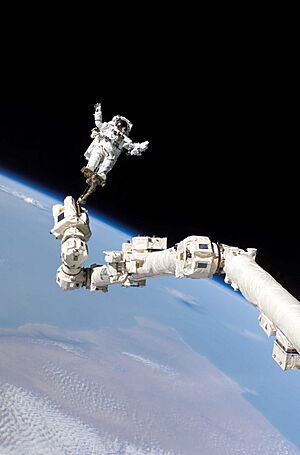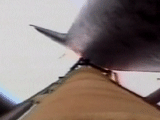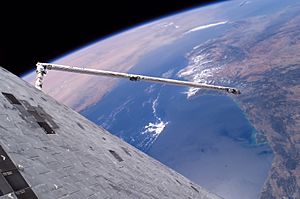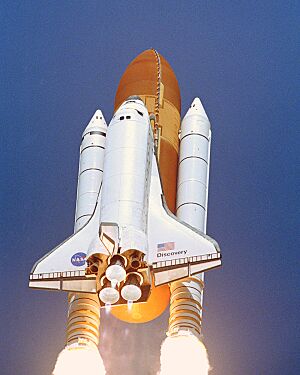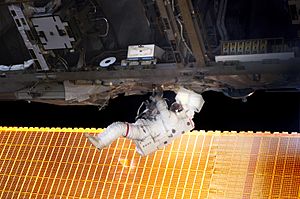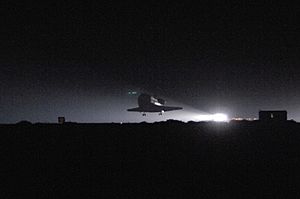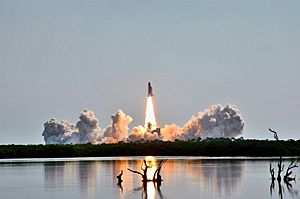STS-114 facts for kids
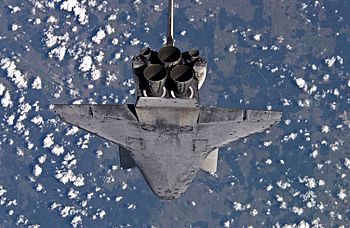
Discovery performing the first ever rendezvous pitch maneuver during STS-114
|
|
| Mission type | ISS logistics |
|---|---|
| Operator | NASA |
| Mission duration | 13 days, 21 hours, 32 minutes, 48 seconds |
| Distance travelled | 9,300,000 kilometres (5,800,000 mi) |
| Orbits completed | 219 |
| Spacecraft properties | |
| Spacecraft | Space Shuttle Discovery |
| Launch mass | 121,483 kilograms (267,824 lb) |
| Landing mass | 102,913 kilograms (226,884 lb) |
| Crew | |
| Crew size | 7 |
| Members |
|
| Start of mission | |
| Launch date | 26 July 2005, 14:39:00 UTC |
| Launch site | Kennedy LC-39B |
| End of mission | |
| Landing date | 9 August 2005, 12:11:22 UTC |
| Landing site | Edwards Runway 22 |
| Orbital parameters | |
| Reference system | Geocentric |
| Regime | Low Earth |
| Perigee | 350 kilometres (220 mi) |
| Apogee | 355 kilometres (221 mi) |
| Inclination | 51.6 degrees |
| Period | 91.59 minutes |
| Epoch | 31 July 2005 |
| Docking with ISS | |
| Docking port | PMA-2 (Destiny forward) |
| Docking date | 28 July 2005, 11:18 UTC |
| Undocking date | 6 August 2005, 07:24 UTC |
| Time docked | 8 days, 19 hours, 54 minutes |
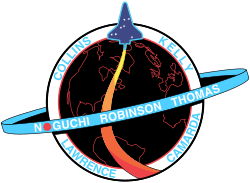 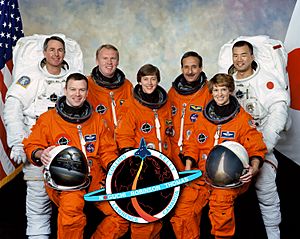 Back (L-R): Robinson, Thomas, Camarda, Noguchi Front (L–R): Kelly, Lawrence, Collins |
|
STS-114 was a very important Space Shuttle mission. It was the first flight after the Columbia disaster. This mission was called "Return to Flight" because it marked the return of space shuttle flights.
The Space Shuttle Discovery launched on July 26, 2005, at 10:39 AM EDT. This was about 29 months after the Columbia accident. The launch happened even though there were some issues with fuel sensors. These problems had stopped the shuttle from launching earlier, on July 13.
The mission ended on August 9, 2005. Discovery landed at Edwards Air Force Base in California. Bad weather in Florida meant the shuttle could not land at its usual spot. During the launch, cameras showed pieces breaking off the external fuel tank. This was a big worry because a similar problem caused the Columbia disaster. Because of this, NASA decided to stop future shuttle flights. They wanted to make more changes to the shuttle's parts. Shuttle flights started again a year later with STS-121 on July 4, 2006.
Contents
Meet the STS-114 Crew
The STS-114 mission had a crew of seven brave astronauts.
| Position | Astronaut | |
|---|---|---|
| Commander | Fourth and last spaceflight |
|
| Pilot | Second and last spaceflight |
|
| Mission Specialist 1 | First spaceflight |
|
| Mission Specialist 2 | Third spaceflight |
|
| Mission Specialist 3 | Fourth and last spaceflight |
|
| Mission Specialist 4 | Fourth and last spaceflight |
|
| Mission Specialist 5 | Only spaceflight |
|
Original Crew Plans
This mission was first planned to take the Expedition 7 crew to the ISS. It would also bring the Expedition 6 crew back home. The original crew list was different from the one that flew.
| Position | Launching Astronaut | Landing Astronaut |
|---|---|---|
| Commander | ||
| Pilot | ||
| Mission Specialist 1 | ||
| Mission Specialist 2 | ||
| Mission Specialist 3 | Expedition 7 ISS Commander |
Expedition 6 ISS Commander |
| Mission Specialist 4 | Expedition 7 ISS Flight Engineer |
Expedition 6 ISS Flight Engineer |
| Mission Specialist 5 | Expedition 7 ISS Flight Engineer |
Expedition 6 ISS Flight Engineer |
Key Moments of the Mission
STS-114 was the first Space Shuttle flight after the Columbia accident. It was also the second time a woman, Eileen Collins, commanded a shuttle mission. She had also commanded STS-93.
The mission was originally planned for the shuttle Atlantis. However, NASA switched it to Discovery. This was because a part in Atlantiss braking system was not installed correctly. Discoverys system was fixed first, so it became the "Return to Flight" vehicle. Interestingly, Discovery had also flown NASA's previous "Return to Flight" mission, STS-26, seventeen years earlier.
Delivering Supplies and Testing Safety
The STS-114 mission brought supplies to the International Space Station. But its main goal was to test new ways to keep the Space Shuttle safe. This included new ways to check and fix the shuttle in space.
The crew used a new tool called the Orbiter Boom Sensor System (OBSS). This was a 50-foot (15 m) extension attached to the Canadarm. The OBSS had cameras and a laser scanner. These tools helped the crew look for damage on the shuttle's heat shield. They checked the wings, nose, and crew area. Engineers also wanted them to check other spots based on videos from launch.
STS-114 was also known as Logistics Flight 1. It carried the Raffaello Multi-Purpose Logistics Module. This module was built by the Italian Space Agency. The mission also brought the External Stowage Platform-2 (ESP-2). The ESP-2 was attached to the side of the Quest Airlock on the ISS. The crew also put the MISSE 5 outside the station. They replaced a broken Control Moment Gyroscope (CMG) on the ISS. The CMG helps control the station's direction.
Spacewalks and Repairs
The crew did three spacewalks during their time at the station.
- The first spacewalk showed how to repair the shuttle's heat shield.
- During the second, astronauts replaced the broken gyroscope.
- On the third, they installed the External Stowage Platform. They also made a repair to the shuttle itself. This was the first time repairs were done on the outside of a spacecraft during a spacewalk.
On August 1, NASA announced that some sticking gap fillers on the shuttle's underside needed to be checked. These were dealt with during the third spacewalk on August 3. Astronaut Stephen Robinson easily pulled out the two fillers with his fingers. Later, NASA said a thermal blanket near the commander's window was also damaged. However, tests showed the shuttle was safe to return to Earth with the blanket as it was.
On July 30, 2005, NASA added an extra day to the mission. This allowed the Discovery crew to help the ISS crew. They also moved more items from the shuttle to the ISS. This was important because it was unclear when the next shuttle would visit the station. The shuttle's arrival also gave the space station a boost in altitude. The station usually loses about 100 feet (30 m) of altitude each day.
The shuttle hatch was closed the night before it left the ISS. After undocking, the shuttle flew around the station. This allowed the crew to take photos of the ISS.
The landing was first planned for August 8, 2005, at Kennedy Space Center. But bad weather delayed it until the next day. Then, it was moved to Edwards Air Force Base in California. Discovery landed there at 08:11 AM EDT.
Launch Day Issues
During the launch, a few things happened:
- About 2.5 seconds after liftoff, a large bird hit the external fuel tank. NASA did not think this would cause problems. The shuttle was moving slowly at that point.
- A small piece of heat shield tile, about 1.5 inches (38 mm) big, broke off. This happened from the front landing gear door. Engineers asked for this area to be checked by the OBSS.
- At 127.1 seconds after liftoff, a large piece of foam broke off the external tank. This piece was about 36 by 11 inches (922 by 279 mm). It weighed about 0.45 kg. This was a big concern because foam breaking off caused the Columbia disaster. Luckily, this piece did not hit Discovery.
- About 20 seconds later, a smaller piece of foam hit the shuttle's right wing. NASA estimated it was not strong enough to cause damage. Laser scans of the wing showed no damage.
On July 27, 2005, NASA announced that all future Shuttle flights would be stopped. They needed to fix the foam loss problem. At first, NASA thought human error caused the foam loss. But in December 2005, X-ray photos showed that temperature changes caused cracks in the tank. This led to the foam breaking off. NASA apologized to the workers who had been blamed for the Columbia disaster.
The next shuttle launch, STS-121, was delayed. It was first hoped for September 2005. But due to Hurricane Katrina hitting NASA facilities, it was delayed until July 4, 2006.
Fixing the Shuttle in Space
During the third spacewalk, astronauts fixed two areas on the shuttle's underside. Photos showed that some "gap fillers" were sticking out. These fillers are not needed for the shuttle to re-enter Earth's atmosphere safely. One filler stops tiles from "chattering" during launch. The other helps reduce heat transfer to the shuttle.
NASA sent instructions and videos to the crew. The videos showed how to fix the problem. Astronaut Stephen K. Robinson easily removed the two fillers with his fingers. He said, "It looks like this big patient is cured."
If he couldn't pull them out, he could have cut them. The gap fillers were made of a ceramic cloth. They were stiff and could be cut with a saw-like tool. Sticking out gap fillers could cause problems during re-entry. They could make the air flow turbulent, which might cause the shuttle to get too hot.
NASA carefully weighed the risks of the spacewalk against the risks of leaving the fillers as they were. They used cameras on the shuttle arm and Robinson's helmet to watch his work.
Another repair was considered for a damaged thermal blanket. This blanket was under the commander's window. But tests showed it was safe for re-entry. So, a fourth spacewalk was not needed.
Mission Timeline: Key Events
This is a summary of important events during the STS-114 mission.
July 13: Original Launch Day
- 11:55 AM EDT: The countdown clock started again after a planned stop.
- 12:01 PM EDT: The crew entered the Astrovan to go to the launch pad.
- 12:30 PM EDT: The crew arrived at Pad 39B and went into the White Room to board the shuttle.
- 1:32 PM EDT: A problem with a fuel level sensor was reported. The launch was stopped.
- 1:34 PM EDT: The crew started to leave the shuttle.
July 14: Postponement
- 2:00 PM EDT: A meeting was held to discuss the sensor problem.
- 2:45 PM EDT: A press conference announced the earliest launch would be July 17.
July 26: Launch Day!
- 08:08 AM EDT: Crew boarding finished.
- 09:00 AM EDT: Shuttle hatch closed.
- 09:24 AM EDT: T -20 minutes and holding.
- 09:34 AM EDT: T -20 minutes and counting.
- 09:45 AM EDT: T -9 minutes and holding.
- 10:27 AM EDT: Launch Control gave the "go" for launch.
- 10:30 AM EDT: T -9 minutes and counting.
- 10:35 AM EDT: T -4 minutes, APU activation finished.
- 10:39 AM EDT: Liftoff! The shuttle cleared the tower.
- 10:47 AM EDT: T +8 minutes, main engines shut down and fuel tank separated as planned.
July 28: Docking with the ISS
- 07:18 AM EDT: Discovery docked with the ISS. This happened after the first-ever Rendezvous pitch maneuver.
July 30: First Spacewalk
- 05:46 AM EDT: Noguchi and Robinson began their first spacewalk.
- 12:36 PM EDT: Spacewalk finished successfully (6 hours, 50 minutes).
August 1: Second Spacewalk
- 04:44 AM EDT: Noguchi and Robinson began their second spacewalk. They replaced a CMG.
- 11:14 AM EDT: Spacewalk finished successfully (6 hours, 30 minutes).
August 3: Third Spacewalk
- 04:48 AM EDT: Noguchi and Robinson began their third spacewalk. Robinson removed two sticking gap fillers. Noguchi installed the amateur radio satellite PCSat2. He also set up the MISSE 5 experiment.
- 10:49 AM EDT: Spacewalk finished successfully (6 hours, 1 minute).
August 6: Undocking
- 01:14 AM EDT: The orbiter crew said goodbye to the ISS crew. Hatches between the shuttle and ISS were closed.
- 03:24 AM EDT: The orbiter undocked from the ISS.
August 8: Landing Delayed
- 03:20 AM EDT: Mission Control canceled the first landing chance due to low clouds.
- 05:04 AM EDT: Mission Control canceled the second landing chance. Landing was delayed to the next day.
August 9: Landing Day!
- 03:12 AM EDT: Mission Control canceled the first landing chance due to bad weather.
- 05:03 AM EDT: Mission Control canceled the second landing chance. Thunderstorms were too close to the Kennedy Space Center. Discovery would now land at Edwards Air Force Base in California.
- 06:43 AM EDT: Capcom (Ken Ham) told Discovery it was "time to come home."
- 07:06 AM EDT: Discovery began its deorbit burn. This slowed the shuttle by about 186 miles per hour (300 km/h).
- 07:09 AM EDT: Deorbit burn finished as planned.
- 07:28 AM EDT: APUs were turned on to power the shuttle's controls.
- 07:40 AM EDT: Discovery started to feel Earth's atmosphere.
- 08:08 AM EDT: Commander Eileen Collins took control of Discovery for the final approach.
- 08:11 AM EDT: Discovery touched down at Edwards Air Force Base.
- 08:12 AM EDT: Eileen Collins reported "Wheel stop."
- 10:13 AM EDT: The crew left the shuttle.
Wake-up Songs
NASA started a tradition of playing music to astronauts. This began during the Gemini program. It was first used to wake up a crew during Apollo 15. Each song is chosen carefully, often by the astronauts' families. The songs usually have a special meaning to an astronaut or relate to their daily tasks.
| Flight Day | Song | Artist | Played for | Links |
|---|---|---|---|---|
| Day 2 | "I Got You Babe" | Sonny & Cher | entire crew | WAV MP3 |
| Day 3 | "What A Wonderful World" | Louis Armstrong | Charles Camarda | WAV |
| Day 4 | "Vertigo" | U2 | James Kelly | WAV |
| Day 5 | "Sanpo" ("Stroll") | from the movie "My Neighbor Totoro", composed by Joe Hisaishi and performed by the Japanese School of Houston | Soichi Noguchi | WAV MP3 |
| Day 6 | "I'm Goin' Up" | Claire Lynch | Wendy Lawrence | WAV |
| Day 7 | "Walk of Life" | Dire Straits | Steve Robinson | WAV MP3 |
| Day 8 | "Big Rock Candy Mountain" | Harry McClintock | Andy Thomas | WAV MP3 |
| Day 9 | "Faith of the Heart" | Russell Watson (Title song of Star Trek: Enterprise) | Eileen Collins | WAV MP3 |
| Day 10 | "Amarillo by Morning" | George Strait | entire crew | WAV MP3 |
| Day 11 | "Anchors Aweigh" | The United States Navy | Wendy Lawrence | WAV MP3 |
| Day 12 | "The Air Force Song" | James Kelly in congratulations on his promotion to Air Force Colonel | WAV MP3 | |
| Day 13 | "The One and Only Flower in the World" | SMAP | Soichi Noguchi | WAV MP3 |
| Day 14 | "Come On Eileen" | Dexys Midnight Runners | Eileen Collins | WAV MP3 |
| Day 15 | "Good Day Sunshine" | The Beatles | entire crew | WAV MP3 |
Tribute to the Husband Family
On flight day 10, the STS-114 crew and the Expedition 11 crew wished Rick Husband's son, Matthew, a happy birthday. Rick Husband was the commander of Columbia on STS-107.
Commander Eileen Collins and Pilot Jim Kelly said: "We know it's still August third down there on the planet Earth, and from the Shuttle Discovery we would like to say 'Happy birthday' to Matthew Husband, who is ten years old today. And Houston, that wake-up music sure makes me think of Rick Husband's mom, who lives in Amarillo, so we'd like to say 'Hi' to Mrs. Husband, too."
Contingency Plans: What if Something Went Wrong?
After the loss of Columbia in STS-107, NASA made plans for rescue missions. If a shuttle had a serious problem, another shuttle would be ready to fly and rescue the crew.
For STS-114, a rescue option called STS-300 was planned. This meant the STS-114 crew would stay on the International Space Station. Then, Atlantis would launch with a four-person crew to bring them back. Discovery would then be guided to crash into the Pacific Ocean.
Another rescue option involved using Russian Soyuz spacecraft. Nikolay Sevastyanov, a director from the Russian Space Corporation Energia, said they could bring nine astronauts home if needed.
Images for kids
-
July 26: Space Shuttle Discovery STS-114 launch.
-
Space Shuttle Discovery rising from the pad at Kennedy Space Center, Florida, July 26, 2005.
See also
 In Spanish: STS-114 para niños
In Spanish: STS-114 para niños


